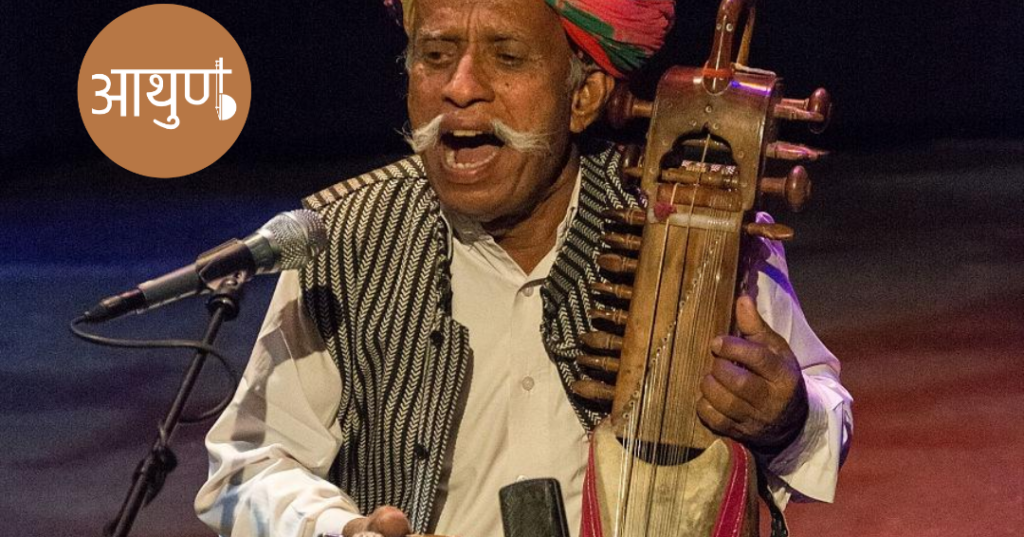


This particular variation of the Sarangi is also called a ‘Sing’ and is a particular type of stringed instrument that is common in the regions of Madhya Pradesh and Rajasthan. The Sindhi Sarangi was originally created to accompany the vocals of a singer as the instrument could precisely imitate the gradations of the human voice.
A horsehair bow presses on the bowed strings while the left-hand cuticles of the player shorten the vibrating length of the strings on the fretless fingerboard during the playing of the Sindhi Sarangi. Sindhi, Muslim and Jogi communities of Rajasthan use the instrument for singing Sufi Kalaams. At times it also used to provide the music for the Kalbeliya dance performances.

There is an entire tradition in Indian music where musical instruments of the stringed variety form a separate classification, termed as chordophone, which means string sounds. Just how old and how endearing is this art of playing on strings in India, it can be reckoned from a legendary tale.
The Rig Veda, the oldest Indian text of the Aryan civilization, contains a reference to the sage Kanwa who was imprisoned by demons. The revered man was blindfolded by his captors and cast into a dark dungeon. The sage had no problem complying with this order, although his eyes were shut, his ears were open. From the stillness of his dark cavern he heard the sounds of a sonorous veena, the oldest string instrument in India which was customarily played at dawn as a musical accompaniment to group recitals welcoming the break of a new day.
According to some musicians, the word Sarangi is a combination of two words ‘seh’ (Persian equivalent of three) and ‘rangi’ (Persian equivalent of colored) corrupted as Sarangi. The term seh-rangi represents the
three melody strings. Sarangi is widely believed to mean “a hundred colours” indicating its adaptability to a wide range of musical styles, its flexible tunability, and its ability to produce a large palette of tonal colour and emotional nuance.
Another school of thought believes that Sarangi is Hindi for ‘of a hundred colours’ or “the voice of hundred colours”. The Idiom is derived from two words of Hindi: “sau” means “100” and ranga which means “colour”. For some scholars, the wor sarangi is believed to be a derivative of Sarang (Sanskrit for ‘spotted deer’).
In Nepal, where Sarangi is an important classical instrument it is believed that the word sarangi is derived from two Nepali words: sau (meaning “seven”) and rang (meaning “colour”). This is because the sound of the sarangi is said to be as expressive and evocative as seven colours.
The Sarangi consists of a squat, truncated body. The classical sarangi is carved out of a single piece of hardwood, usually tun (sometimes called Indian cedar). This is between 64 and 76 centimeters in length. The instrument has a roughly rectangular slightly waisted body- a goatskin face on which rests an elephant-shaped bridge of ivory or bone and broad fretless neck.
The strings are suspended by four bone bridges: one bridge carries the playing and the sympathetic strings through different notches, the second bridge raises the main playing strings approximately half-an-inch above the instrument. Two bridges carry five or six sympathetic strings each. These bridges resemble the sitar bridge and, similarly, serve to enhance the tone.
It has three melody strings which are usually made of gut and around thirty-five metal sympathetic strings which provide a bright echo. The strings pass over and through an elephant-shaped bridge usually made of bone or ivory. This rests on a leather strap which protects the instrument’s goatskin face. The bow, held with an underhand grip, is usually made of rosewood or ebony and is considerably heavier than Western violin or cello bows, contributing to the solidity and vocal quality of the sarangi’s sound.
The nineteenth century sarangi was a smaller and less standardised instrument, and it is possible that the unwieldy complexity of the modern instrument has contributed to its decline as an accompaniment instrument and to solo sarangi’s relatively low profile on the modern concert stage. But the sarangi’s decline has been largely precipitated by social forces.
“Sindhi Sarangi ” is the traditional instrument of “Langa” professional caste musicians in western Rajasthan. It has nearly 26 strings, in which four main strings (called Baj ke taar) where bow plays. The first two strings are made of steel and the following two strings are made of locally prepared gut.